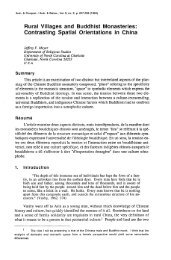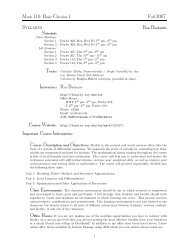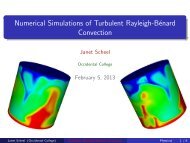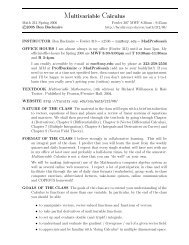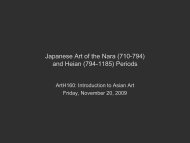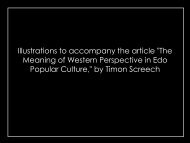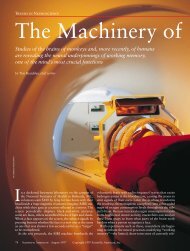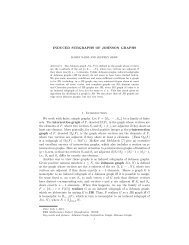A Primer on Japanese Hell Imagery and Imagination - Occidental ...
A Primer on Japanese Hell Imagery and Imagination - Occidental ...
A Primer on Japanese Hell Imagery and Imagination - Occidental ...
You also want an ePaper? Increase the reach of your titles
YUMPU automatically turns print PDFs into web optimized ePapers that Google loves.
32<br />
M<strong>on</strong>umenta Nipp<strong>on</strong>ica 63:1<br />
freely combined or isolated comp<strong>on</strong>ents to suit the tastes <strong>and</strong> dem<strong>and</strong>s of patr<strong>on</strong>s<br />
<strong>and</strong> audiences.<br />
Many temples owned paintings of the ten kings. Typically, each king had his<br />
own scroll, shared with a h<strong>on</strong>ji, an assortment of officers, dem<strong>on</strong>s, <strong>and</strong> defendants,<br />
<strong>and</strong> vignettes of hell or other realms, as in paintings we have c<strong>on</strong>sidered.<br />
There were also innovati<strong>on</strong>s, such as those seen in a set of seven hell paintings<br />
at Zenshôji (Ishikawa prefecture) that depict spindly sinners mauled by<br />
athletic dem<strong>on</strong>s against a spare brownish background, each scene divided from<br />
the next by geometrically shaded framing. The <strong>on</strong>ly king represented is Enma,<br />
sitting at his desk in <strong>on</strong>e scroll <strong>and</strong> looming over hell’s cauldr<strong>on</strong> in another, as<br />
if orchestrating its tortures amidst the flames (see figure 6). Dem<strong>on</strong>s drive four<br />
oxen over the t<strong>on</strong>gue of <strong>on</strong>e sinner, while other sinners are attacked by dogs,<br />
crows, insects, foxes, mice, fish, snakes, drag<strong>on</strong>s <strong>and</strong> other mythical beasts, a<br />
m<strong>on</strong>strous turtle, <strong>and</strong> even an elephant. 119<br />
<strong>Hell</strong> imagery was displayed routinely at temples, festivals, <strong>and</strong> marketplaces.<br />
In the late medieval <strong>and</strong> early modern periods, Kumano bikuni (“Kumano nuns”)<br />
used portable Kumano kanjin jikkai zu for etoki picture narrati<strong>on</strong>, c<strong>on</strong>tributing<br />
to the presence of hell in the streets. These paintings incorporated new<br />
hells for women, such as the <strong>Hell</strong> of the Blood Lake, the <strong>Hell</strong> of Barren Women,<br />
<strong>and</strong> the <strong>Hell</strong> of Two Women, further transforming <strong>Japanese</strong> c<strong>on</strong>cepti<strong>on</strong>s. Etoki<br />
performances of Tateyama m<strong>and</strong>ara by priests from the foothills of<br />
Tateyama in present-day Toyama prefecture added to the currency of women’s<br />
hells. Known as a site of hell since the classical period, the mountain became<br />
c<strong>on</strong>nected to women’s salvati<strong>on</strong> during the early modern period through a new<br />
c<strong>on</strong>cocti<strong>on</strong> of hell <strong>and</strong> salvati<strong>on</strong> motifs. 120 These types of images rendered hell<br />
in shorth<strong>and</strong>. Reduced to the most rudimentary elements, scenes of Enma at his<br />
desk, sinners chased by dem<strong>on</strong>s, t<strong>on</strong>gues extracted, <strong>and</strong> bodies pulverized or<br />
falling into fire were nevertheless instantly recognizable. Such images had become<br />
so ubiquitous <strong>and</strong> deeply etched in the popular c<strong>on</strong>sciousness that a visual<br />
hint sufficed to summ<strong>on</strong> a host of terrifying stories <strong>and</strong> images.<br />
Dating back at least to the early eighteenth century, nozoki karakuri<br />
were another innovati<strong>on</strong> in the public display of hell imagery. Viewers peeked<br />
into a box at a series of painted scenes for which transparent paper placed strategically<br />
over scored secti<strong>on</strong>s <strong>and</strong> lit from behind provided depth <strong>and</strong> drama. <strong>Hell</strong><br />
<strong>and</strong> heaven were am<strong>on</strong>g the oldest themes displayed in these miniature theaters.<br />
121 Much as with the preaching of Kumano bikuni, nozoki karakuri may<br />
have originated in efforts to teach Buddhism to comm<strong>on</strong>ers, but developed into<br />
a form of popular entertainment. Board games called sugoroku that featured<br />
paradise or buddhahood as a goal <strong>and</strong> hell as a booby trap also had roots in teaching<br />
<strong>and</strong> proselytizing. Perhaps originally developed as an aid to memorizing the<br />
119 See Anoyo no jôkei, pp. 60–75.<br />
120 On Tateyama m<strong>and</strong>ara, see the author’s forthcoming book. Also see note 63 above.<br />
121 See Nei 2005; <strong>and</strong> Nei 2007, pp. 138–40, 397–99, etc.



